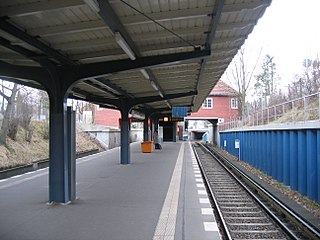
Berlin Schönhauser Allee is a railway station in the Prenzlauer Berg district of Berlin. It is located on the Berlin U-Bahn line U2 and also on the Ringbahn . Built in 1913 by A.Grenander opened as "Bahnhof Nordring". As the station was well accepted the roof was elongated in 1925 and a new entrance built. In 1936 the station was named "Schönhauser Allee". On an average day approximately 500 trains and more than 26000 people cross this station.

Freie Universität (Thielplatz) is a Berlin U-Bahn station located in the Dahlem district on the U3. It is one of two main stations to reach the nearby Freie Universität Berlin and the Fritz Haber Institute of the Max Planck Society. It was opened on 12 October 1913 and until 1929 was the southwestern terminus of the line. In 1980, a second entrance was built. In December 2016 the station was renamed from "Thielplatz" to "Freie Universität (Thielplatz)"

Krumme Lanke, literally “Crooked Lake“, is a Berlin U-Bahn station on the U3. It is the line's southwestern terminus, located in the Zehlendorf district of Berlin.

Viktoria-Luise-Platz is a Berlin U-Bahn station located on the U4. In 1910, Town of Schöneberg, now a part of Berlin, built its subway line, the U4. This station was built by E.Deneke. This shallow station is decorated by green and white tiles on the walls as well as green tiles on the columns. Both the square and the subway station are protected by law as historic landmarks.

Schillingstraße is a Berlin U-Bahn station located on the U5.

Strausberger Platz is a Berlin U-Bahn station located on the U5 line.

Friedrichsfelde is a Berlin U-Bahn station located on the U5 in the Friedrichsfelde district.

Kurt-Schumacher-Platz is a station on the U6 line of the Berlin U-Bahn. There had been a bus link outside the station connecting Berlin's Tegel International Airport to the U-Bahn network. The station was opened on 3 May 1956 and named after famous German politician Kurt Schumacher.

Alt-Tegel is a Berlin U-Bahn station located on the U6.t It was constructed by B. Grimmek and opened as "Tegel" station in 1958. In 1992, the station was renamed to Alt-Tegel. The S-Bahn station Berlin-Tegel is located nearly 600 meters away. The renaming of the Tegel U-Bahn station perhaps occurred to avoid confusion.

Otisstraße is a Berlin U-Bahn station located on the U6 line.

Reinickendorfer Straße is a Berlin U-Bahn station located on the U6.

Konstanzer Straße is a Berlin U-Bahn station located on line U7 in the Wilmersdorf district.

Johannisthaler Chaussee is a Berlin U-Bahn station located on the U7. It was opened in 1970 by its architect Rainer G. Rümmler, and got the addition "Gropiusstadt" in 1972.

Britz-Süd is a Berlin U-Bahn station located on the U7. It was opened in 1963 and constructed by W.Düttmann. Characteristics are the grey tiles on the walls. Until 2003 this station only had a southern entrance. In 2003 the northern entrance was opened due to BVG safety policies. The station is only 3,5m below the street. The next station is Johannisthaler Chaussee.

Bernauer Straße is a Berlin U-Bahn station located on the U8.

Weinmeisterstraße is a Berlin U-Bahn station located on the U8.

Heinrich-Heine-Straße is a Berlin U-Bahn station on the U8, located under the street of the same name in Mitte, and protected as an architectural landmark. The street and the station were called Neanderstraße until 1960.

Birkenstraße is a Berlin U-Bahn station located on the U9 line. It was opened in 1961 by B. Grimmek. There are two entrances to the station, located at the Birkenstraße and Wilhelmshavenerstraße crossroad, on either side of the road. The station's walls are decorated with green tiles in reference to the station's name—the word birke is German for birch tree.

Mangfallplatz is an U-Bahn station in Munich on the U1 line of the Munich U-Bahn system. Opened on 9 November 1997, it is the southernmost station on the line.

Wedel station is a railway station on the Altona-Blankenese line, served by the rapid transit trains of the Hamburg S-Bahn, located in Wedel, Germany.
This page is based on this
Wikipedia article Text is available under the
CC BY-SA 4.0 license; additional terms may apply.
Images, videos and audio are available under their respective licenses.





















